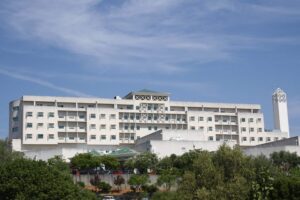Salt. NaCl. Sodium Chloride … such a seemingly simple chemical, and yet one with a most intriguing history and a complex relationship with humans.
Physiologically, without the elements of salt, there would be no life, as all living beings rely on the positive/negative ion exchange of the sodium (Na+)/chloride (Cl-) pump. This pump drives every single physiological process in the body … except for the heart that is, which relies on a potassium (K+)/chloride (Cl-) pump.
Salt is naturally derived from the diet, with meat containing higher concentrations of salt than plants, which is the reason why herbivorous animals often find natural salt deposits (salt licks) to supplement and replenish their electrolyte balance. They congregate around them and sometimes also use them almost like way points during migrations.
These natural salt deposits come from ancient seas, some already dried up, like the Kalahari salt pans, and others still “living” … like the Dead Sea for example. Some of these deposits can follow cracks in the surface of the earth’s crust and form deep veins and shafts, like the famous Wieliczka salt mine in Poland, one of the world’s largest and oldest mines.
The relationship between humans and salt began many millennia ago.
Humans hunted game and followed their tracks to the salt licks. As their diet encompassed plants, they realized that adding salt made the food taste “meatier” in some ways. This was followed by the realisation that it also prevented food from spoiling thus allowing humans to start preserving and storing foods and animal hides for the more inclement seasons when hunting, foraging and harvesting was more difficult or impossible.
The earliest salt-harvesting facilities, dating back to circa 6000BC, were found in present-day Romania and China. Salt became a precious trading commodity with specific trade routes, spreading from sub-Saharan Africa and Asia, to bring this scarce commodity to Europe.
At times worth its weight in gold, it even became currency in Abyssinia at one stage. And the majority of Venice’s opulent wealth in the early 12th century was solely attributable to its salt trade.
Salt was not only a condiment and curing/preserving agent, it also had medicinal and anti-septic uses. In fact, the name “salt” or “sal” is derived from the Roman goddess of health, Salus.
Ancient Egyptian medical texts refer to salt as an important ingredient in the treatment of wounds as well as in the making of anti-infective and laxative medications.
Hippocrates in 460BC advocated the use of salt for the treatment of skin ulcers, digestive upsets and even salt-water steam inhalations as an expectorant. Similar uses were also advocated by the Roman physician Galen, and the Persian physician Avicenna strongly advocated the importance of iodine and iron in sea salt for the use in infected wounds.
During the Medieval times, the first so-called “medical university”, the School of Salerno, produced a book called The Art of Staying Healthy, which explicitly recommended salted bread and salted food, stating that it drove off toxins. The book, however, also warned against the use of too much salt: “Over-salted food diminishes semen and eyesight – salt burns, makes one fretful, shabby, scabby and wrinkly…”
In the 19th century, pharmacists and physicians recommended internal ingestion of salt for stomach upsets, goitre, glandular diseases, intestinal worms, dysentery, dropsy, epilepsy, and syphilis. Topical application was advised for rashes, joint swellings or pain, and in ophthalmology, to drive off “stains and stain-obscurations of the cornea”. A salt-based enema was even supposed to work for patients who were “seemingly dead and apoplectic”.
So, why has salt become such a maligned pariah in modern medicine?
Salt, in human physiology, is essential to maintain the balance of electrolytes and fluids, carry nutrients into cells, to regulate the acid-base balance, and aid secretion of gastric acid, as well as to support the transfer of nerve impulses and to regulate blood pressure. And just as with any other element, nutrient or supplement, too much is never a good thing. Everything needs to remain in equilibrium to maintain a homeostatic balance.
As salt became an easily accessible commodity in our modern times, so our innate appetite for salt increased, with some physicians comparing our salt-addiction to the epidemic sugar-addiction. From an anthropological point of view, it is noteworthy that those population groups who live mainly on protein and milk or who drink salty water do not generally salt their food, whereas those who live mainly on vegetables, rice and cereals use much more salt.
Similar comparisons can be drawn to populations which live in much hotter climates where natural salt loss through sweating is far more prevalent. It is not by co-incidence that many military survival kits always contain a piece of rock salt, especially when going into jungle or desert environments.
Salt became the scapegoat for the increased incidence of high blood pressure amongst the general population. Everyone got told to stop using salt or reduce their salt intake to control their blood pressure, but the actual advice should be focused more on the quality and type of diet that is being ingested.
Processed and strongly condimented foods are heavy in salt and sugars, and if the individual’s diet predominantly consists of them, then yes, the salt intake needs to be seriously reduced. However, if you follow a very clean way of eating, preparing all your meals from scratch, by default, your salt intake should be minimal and curbing it even further may actually be detrimental to one’s health. Add to that our increasing obsession with drinking loads of water and ingestion of other salt-lowering medications can then further dilute and diminish salt levels in the body.
Low sodium levels can lead to chronic lethargy, poor concentration, nausea and vomiting, muscle weakness and cramps and even seizures in the most extreme cases. Balance and equilibrium is key … and regular checks on your salt and other electrolyte levels is a quick and reliable way of keeping your body as healthy as optimally possible.
So, to salt or not to salt … that is an individual choice and question.
By Dr Jo
|| features@portugalresident.com
Dr Joanna Karamon is a General Practitioner with over 20 years’ experience. She is Clinical Director of Luzdoc International Medical Services Network
























